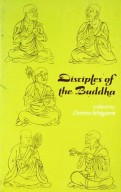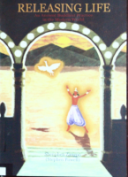Tìm Sách
Sách tiếng Anh-English >> Disciples of Buddha
Thông tin tra cứu
- Tên sách : Disciples of Buddha
- Tác giả : Zenno Ishigami
- Dịch giả :
- Ngôn ngữ : Anh
- Số trang : 200
- Nhà xuất bản : Kosei Publishing Co. Tokyo
- Năm xuất bản : 1989
- Phân loại : Sách tiếng Anh-English
- MCB : 12100000011631
- OPAC :
- Tóm tắt :
INTRODUCTION
The history of Buddhism begins with Shakyamuni, the historical Buddha, who lived in India over twenty-five hundred years ago. Shakyamuni propagated his teachings orally, mainly in the course of many long journeys on foot in northeastern India. The early Buddhist scriptures include many accounts of Shakyamuni addressing villagers, listening to the elderly, teaching and admonishing his disciples, and talking with adherents of other religions. He comforted disciples who were troubled in spirit or physically ill, encouraging them and seeking to awaken them to eternal truths. Sometimes he would rest in the shade of tall trees along country roads, enjoying a brief respite as he chatted with his disciples. It was through these varied contacts that more and more disciples were drawn to the Buddha and to the Sangha, the monastic community of believers.
The Buddha was a person of great tolerance and magnanimity: he did not recognize the hierarchy of castes that was so entrenched in the India of his day but admitted anyone into the Sangha, from priestly Brahman to lowly Sudra. Precedence within the Sangha depended not on birth or social status but simply on seniority. Many people who had been of low status in secular society distinguished themselves in the Sangha.
When he attracted his first five followers, the nucleus of the Sangha, the Buddha was unknown in most of India, no doubt partly because the land of his birth was a small one in the far north of the subcontinent. No matter how well known he may have been in his own country, the kingdom of the Shakyas, it was quite otherwise in such great states as Magadha and Kosala. Around that time a famous religious teacher named Sanjaya was active in Rajagaha, the capital of Magadha. He had two especially outstanding disciples, Sariputta and Moggallana*The Buddha’s conversion of these two, who then persuaded the rest of Sanjaya’s disciples to follow them, marked a major turning point in the development of the Sangha. Thanks to this mass conversion, the Buddha’s name quickly became known throughout northeastern India.
If we wish to understand the Buddha and the age in which he lived, it is extremely helpful to study the lives of his disciples. After the Buddha’s death his disciples recollected as accurately as possible their teacher’s words and deeds and strove to emulate them. We must never forget that the earliest Buddhist scriptures were based on the reminiscences of these disciples, who transmitted his words and deeds as faithfully as memory permitted. It was through their teaching of the Way to enlightenment that the Sangha continued to grow. As might be expected, there was opposition to the Buddha and his teachings. For example, the Buddha’s cousin Devadatta, who tried to revive extreme ascetic practices that the Buddha had discarded, came to be regarded in later times as a rebel and a heretic. Devadatta promoted practices that bore no relation whatsoever to the ordinary life of society. There were those who agreed with him, and a split developed in the Sangha. Sariputta and Moggallana set out to persuade the misled disciples of their error and succeeded in bringing some of them back to the fold. In the end, Devadatta severed all relations with the Sangha. It is this fact that led early Buddhists to brand him a traitor to Buddhism; yet in later scriptures he is presented as the object of the Buddha’s compassion and is described as finally attaining enlightenment.
Sariputta and Moggallana died when the Buddha was well advanced in years. Indeed, the Buddha’s last years were filled with sorrowful events. Nevertheless, he continued to watch over his disciples with deep compassion. This is illustrated by a passage in the Anguttara-nikaya, an early scripture, that lists briefly the ways in which various disciples were preeminent. y “Monks, chief among my disciples who are monks of long standing is Anna-Kondanna. Chief among those of great wisdom is Sariputta. Chief among those of supernatural powers is Great Moggallana. Chief among those who uphold minute observance of forms is Kassapa the Great.” The list continues, naming forty-one monks, thirteen nuns, eleven laymen, and ten laywomen as outstanding in some quality.
Chulla-Panthaka, for example, is noted as the disciple foremost in manifesting different physical forms at will and also as foremost in liberating the mind. He, who had been regarded as a fool, is given not one but two epithets of praise. Lakuntaka-Bhaddiya is listed as foremost in beauty of voice, Sona-Kutikanna as foremost in speaking well, and Sivali as foremost in receiving alms when out begging. Still more interesting is the fact that Kunda-Dhana is described as “the first to receive food tickets.” During the rainy season, when it was impossible for the monks to go out on their begging rounds, they took their meals together in the refectory; at such times Kunda-Dhana was always the first to arrive to receive the necessary food ticket.
The monk listed as foremost among “those who assign quarters” is Dabba-Mallaputta, from which we can tell that specific tasks were assigned to monks in the Sangha. The Buddha’s half brother, Nanda, was unable to forget his wife even after entering the Sangha, and was therefore regarded as being particularly prone to the weaknesses of the flesh. Yet he is listed as the monk foremost among those “who guard the doors of sense.” He is praised in this way because he illustrates that even a man of weak character can learn to strengthen himself and control his desires under the Buddha’s guidance.
Radha is described as continually asking questions about everything. The Buddha once rebuked him for asking about things that had no connection with religious practice and pursuit of the Way. But Radha must have learned to bring his curiosity and argumentativeness under control, for he is warmly praised as foremost among “impromptu speakers.” Mogharajan was foremost among “wearers of coarse robes,” and the Buddha is said to have advised the other monks to model themselves on him in this regard.
The truth is that everyone has some strong point or talent that others might well emulate. This list teaches us that we should not despise ourselves but should practice diligently so that even our weaknesses may in time become strengths.
As the account in the Anguttara-nikaya shows, the Buddha gave his compassionate attention to all his disciples, without discriminating among them in any way. It is not hard to see why the disciples so loved and venerated their teacher. These brief descriptions of disciples enable us to glimpse their individual characters—humorous, or playful, or not quite up to the mark in some respect. And the nature of their teacher is thrown into clear relief as we see him discerning their characters and then providing the helpful advice each one needs. Taken together, the descriptions convey the manifold aspects of the Buddha’s greatness.
When we speak of the Buddha’s disciples, we usually mean the so-called ten great disciples. Yet the Buddha himself treated all his disciples equally; he himself never used the expression “the ten great disciples.” That term derives from a later age, when Buddhists selected the ten who seemed most eminent to them. In fact there are several lists of ten, though the following disciples are most often included: Sariputta, Moggallana, Maha-Kassapa, Upali, Ananda, Anuruddha, Rahula, Kacchayana, Subhuti, and Punna-Mantaniputta. But it is important to realize that there are other groupings of eminent disciples, as well. There are the sixteen arahants who are said to have vowed to one another that they would faithfully transmit the Buddha’s teachings, and the five hundred arahants who assembled immediately after the Buddha’s death to compile the Buddhist canon. All these disciples have been revered through the centuries in Buddhist lands.
This book presents the stories of twenty-eight disciples: the above-mentioned ten great disciples and eighteen other disciples, both ordained and lay. Readers will find that not all the Buddha’s disciples were “model students” from the start. Some gave, in to sloth in the course of their religious practice and began to fall away, only to be reawakened by the admonitions of the Buddha and more advanced disciples. Others reached a spiritual impasse at a certain stage of their practice and had to endure great mental suffering to attain enlightenment. Still others found themselves unable to sever their attachments to the world even after entering the Sangha; some joined the Sangha and left it several times before finally attaining enlightenment. Sharing the experiences of these disciples not only teaches us about their varied approaches to religious practice but also helps us understand the warm relationship they enjoyed with the Buddha.
The tales in this book are adapted from accounts of disciples recorded in the original Pali texts or Chinese translations of a variety of early scriptures. The sources include the Agama sutras; the Nikayas, including the above-mentioned Anguttara-nikaya; the Vinaya-pitaka; the Theragatha (Verses of the Elder Monks) and the Therigatha (Verses of the Elder Nuns), together with their commentaries; the Dhammapada (Verses on the Law) and its commentary, the Dham-mapada-atthakatha; and the Avadana literature. Because the book is intended for easy reading rather than scholarly scrutiny, I have not specified what portions of each story are taken from which text. I have also taken the liberty of slightly adapting passages quoted from the scriptures.
Most personal and place names are transliterated from Pali, the language of the earliest scriptures, but a few names and terms that are best known in their Sanskrit forms are transliterated from that language instead. Interested readers will find the orthodox Pali and Sanskrit transliterations of major names and terms in the glossary.
Zenno Ishigami
PROFESSOR OF BUDDHIST STUDIES
TAISHO UNIVERSITY, TOKYO
CONTENTS
Introduction……………………7
THE TEN GREAT DISCIPLES
Sariputta, Foremost in Wisdom……………………17
Moggallana, Foremost in Supernatural Powers……………………25
Maha-Kassapa, Foremost in Ascetic Practices……………………31
Upali, Foremost in Keeping the Precepts……………………37
Ananda, Foremost in Hearing Many Teachings……………………45
Anuruddha, Foremost in Divine Insight……………………51
Rahula, Foremost in Quietly Doing Good……………………57
Kacchayana, Foremost in Explaining the Dharma……………………62
Subhuti, Foremost in Understanding the Doctrine of the Void……………………67
Punna-Mantaniputta, Foremost in Teaching the Dharma……………………73
OTHER DISCIPLES
Dabba, the Servant of the Sangha……………………79
Ambapali, the Courtesan Who Became a Nun……………………86
General Siha, the Challenger of the Buddha……………………92
Sujata, the First Female Lay Disciple……………………99
Chitta, the Wavering Monk……………………105
Sona, the Loving Mother……………………112
Ugga, the Cheerful Giver……………………118
Visakha, the Woman of Great Generosity……………………124
Channa, the Former Slave……………………131
Dhammadinna, the Conqueror of the Passions……………………138
Kutadanta, the Brahman Who Learned the True Meaning of Sacrifice………145
Isidasi, the Bane of Three Husbands……………………153
Sunita, the Night-Soil Carrier……………………160
Bhadda, the Robber’s Wife……………………166
Sundarinanda, the Nun Trapped by Her Beauty……………………173
Bhaddiya, the King Who Became a Monk……………………179
Tissa, the Old Man Who Loved Leisure……………………187
Punna, the Man of Courage……………………195
Glossary……………………200
 Facebook
Facebook
 Google
Google
 Google+
Google+


















